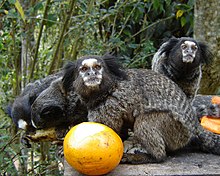Black marmoset
| Black marmoset | ||||||||||||
|---|---|---|---|---|---|---|---|---|---|---|---|---|

Black marmoset ( Callithrix penicillata ) |
||||||||||||
| Systematics | ||||||||||||
|
||||||||||||
| Scientific name | ||||||||||||
| Callithrix penicillata | ||||||||||||
| ( É. Geoffroy Saint-Hilaire , 1812) |
The black marmoset ( Callithrix penicillata ), also known as black brush monkey or monkeys , is a primate species from the marmoset family .
description
Black marmosets are, like all marmosets, relatively small, they reach a head body length of 19 to 22 centimeters and a weight of up to 350 grams. Their fur is gray on their back and limbs, their belly and head are black. The tail is striped gray and white. The face is covered with white hair. They have the tufts of ears that are typical of marmosets, which are black in color. The limbs are rather short, as in all marmosets there are claws instead of nails on the fingers and toes (with the exception of the big toe).
distribution and habitat
Black marmosets are native to central and eastern Brazil , and their range extends from Goiás to Bahia and São Paulo . They mostly inhabit the dry forests of the Cerrado and are often found along rivers.
Introduced populations exist in some Brazilian regions such as Espírito Santo , Paraná, and Santa Catarina .
Way of life
Black marmosets are diurnal tree-dwellers that move on all fours and jump through the branches. They live in groups of 2 to 14 animals, the groups are usually organized around a reproductive couple. The groups live in relatively small areas of 1.25 to 4.5 hectares.
The food of the black marmosets consists largely of tree sap. Like all marmosets , thanks to their specialized teeth, they are able to gnaw holes in the tree bark to get to this source of food. They also eat fruits, insects and sometimes small vertebrates.
After a gestation period of around 150 days, the female gives birth to the offspring, as with all marmosets twin births predominate. The father and also the older siblings participate intensively in the rearing of the young animals. These are weaned at around two months and are sexually mature in the second year of life.
threat
Black marmosets have a relatively large range and are listed as not endangered by the IUCN . They are adaptable and can also cope with partially cleared forests. Sometimes they are caught and made into pets .
literature
- Thomas Geissmann : Comparative Primatology. Springer-Verlag, Berlin et al. 2003, ISBN 3-540-43645-6 .
- Don E. Wilson , DeeAnn M. Reeder (Eds.): Mammal Species of the World . A taxonomic and geographic Reference. Johns Hopkins University Press, Baltimore MD 2005, ISBN 0-8018-8221-4 .
